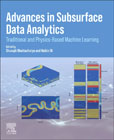
Advances in Subsurface Data Analytics: Traditional and Physics-Based Machine Learning
Bhattacharya, Shuvajit
Di, Haibin
Advances in Subsurface Data Analytics: Traditional and Physics-Based Approaches brings together the fundamentals of popular and emerging machine learning (ML) algorithms with their applications in subsurface analysis, including geology, geophysics, petrophysics, and reservoir engineering. The book is divided into four parts: traditional ML, deep learning, physics-based ML, and new directions, with an increasing level of diversity and complexity of topics. Each chapter focuses on one ML algorithm with a detailed workflow for a specific application in geosciences. Some chapters also compare the results from an algorithm with others to better equip the readers with different strategies to implement automated workflows for subsurface analysis. Advances in Subsurface Data Analytics: Traditional and Physics-Based Approaches will help researchers in academia and professional geoscientists working on the subsurface-related problems (oil and gas, geothermal, carbon sequestration, and seismology) at different scales to understand and appreciate current trends in ML approaches, their applications, advances and limitations, and future potential in geosciences by bringing together several contributions in a single volume. Covers fundamentals of simple machine learning and deep learning algorithms, and physics-based approaches written by practitioners in academia and industry Presents detailed case studies of individual machine learning algorithms and optimal strategies in subsurface characterization around the world Offers an analysis of future trends in machine learning in geosciences INDICE: Part 1: Traditional Machine Learning Approaches 1. User Vs. Machine Seismic Attribute Selection for Unsupervised Machine Learning Techniques: Does Human Insight Provide Better Results Than Statistically Chosen Attributes? 2. Relative Performance of Support Vector Machine, Decision Trees, and Random Forest Classifiers for Predicting and Classifying Production Success in US Unconventional Shale Plays Part 2: Deep Learning Approaches 3. Recurrent Neural Network for Facies Classification 4. Recurrent Neural Network for Seismic Reservoir Characterization 5. Application of Convolutional Neural Networks for the Classification of Siliciclastic Core Photographs 6. Convolutional Neural Networks for Fault Interpretation - Case Study Examples around the World Part 3: Physics-based Machine Learning Approaches 7. Scientific Machine Learning for Improved Seismic Simulation and Inversion 8. Prediction of Acoustic Velocities using Machine Learning 9. Regularized Elastic Full Waveform Inversion using Deep Learning 10. A Holistic Approach to Computing First-arrival Traveltimes using Neural Networks Part 4: New Directions 11. Smart Proxy Modeling Application of Artificial Intelligence and Machine Learning in Computational Fluid Dynamics
- ISBN: 978-0-12-822295-9
- Editorial: Elsevier
- Encuadernacion: Rústica
- Páginas: 295
- Fecha Publicación: 20/04/2022
- Nº Volúmenes: 1
- Idioma: Inglés
